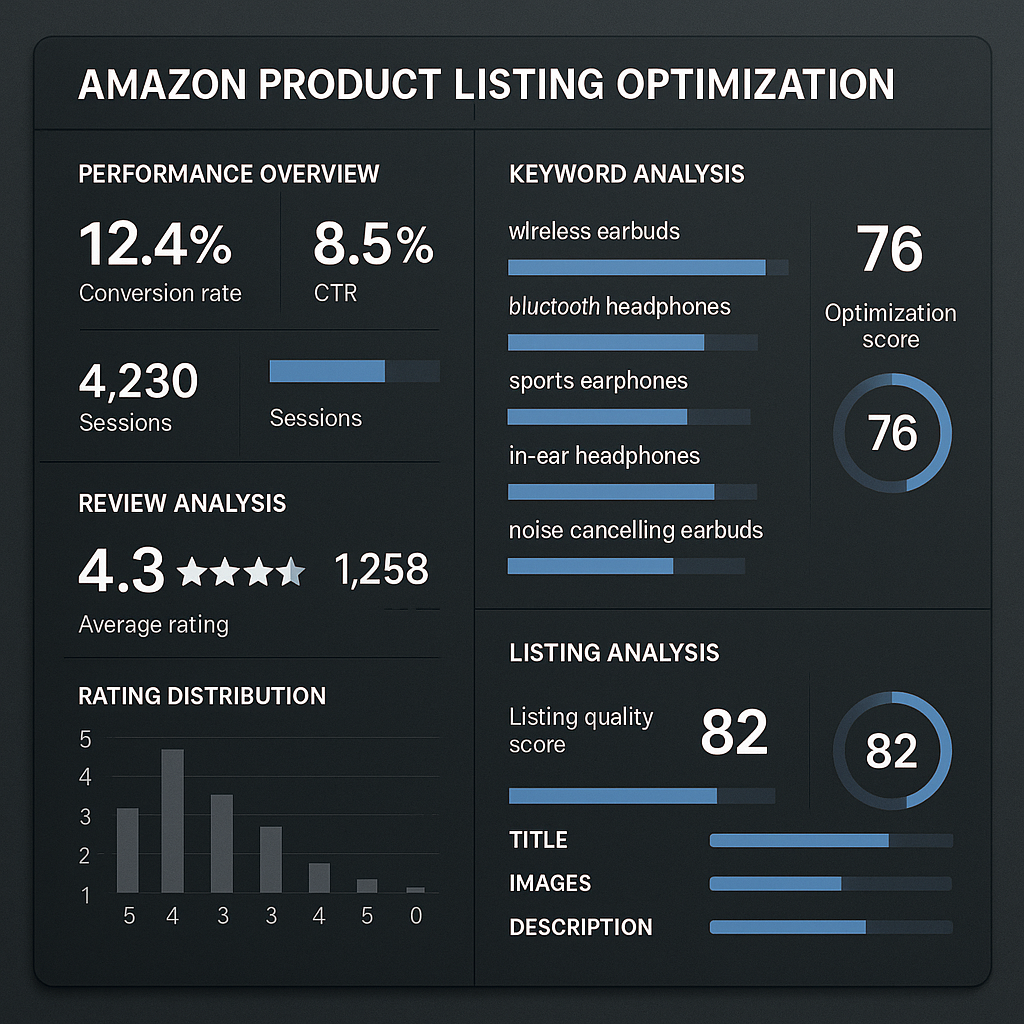Amazon product listing optimization is the strategic enhancement of your product detail pages to improve visibility, attract the right customers, and drive conversions in Amazon's competitive marketplace. In today's crowded e-commerce landscape, simply listing products isn't enough—sellers must craft listings that align perfectly with Amazon's algorithm and buyer expectations. A well-optimized listing can be the difference between page-one visibility with consistent sales and being buried among millions of competing products.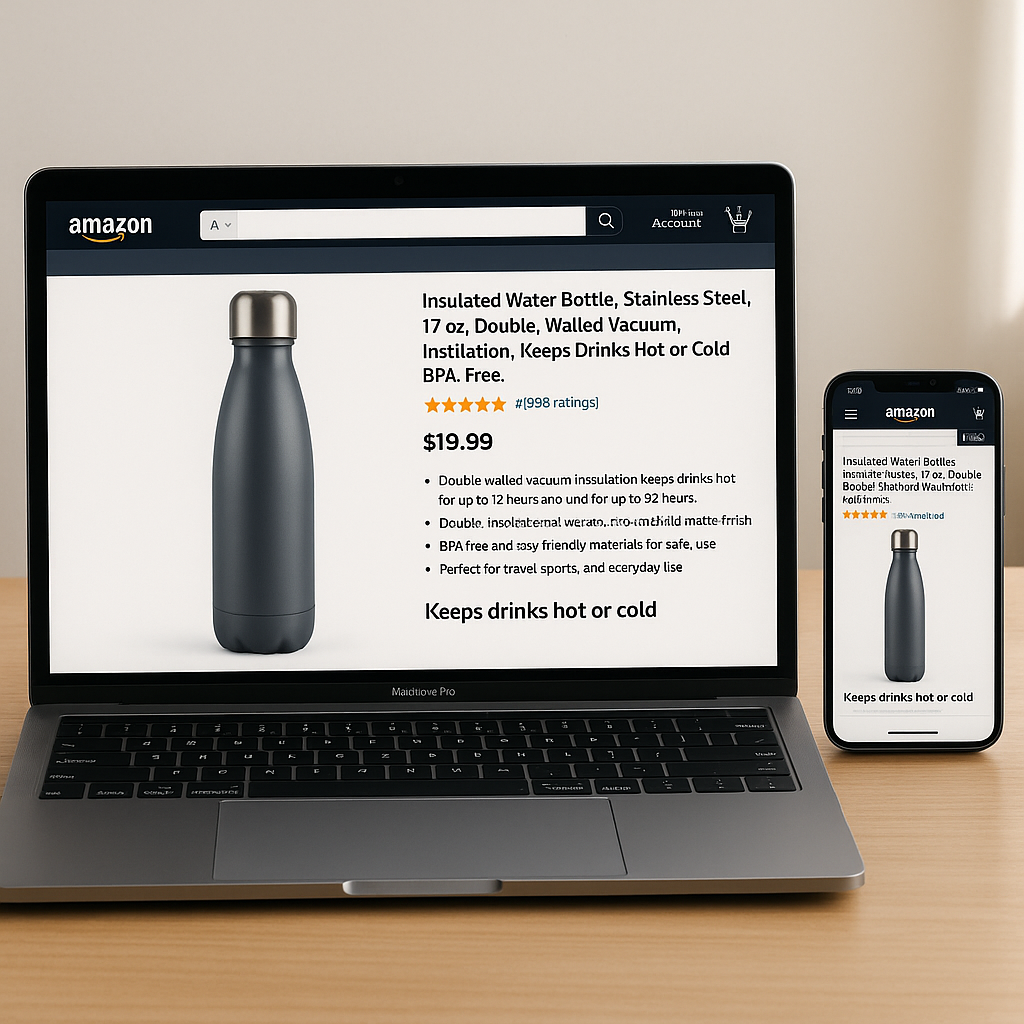
Understanding Amazon's ranking algorithm and search intent
Amazon's A10 algorithm determines which products appear in search results and in what order. Unlike Google, which prioritizes information relevance, Amazon's algorithm is focused on driving sales. It evaluates listings based on multiple performance metrics including sales history, conversion rate, relevancy to search terms, pricing competitiveness, and inventory levels.
The algorithm strongly favors products that generate revenue for Amazon, so listings with high click-through and conversion rates naturally rank better. Additionally, factors like seller authority (feedback score, account health) and fulfillment method (with FBA generally preferred) contribute to your product's visibility.
According to Amazon's own guidance for sellers, relevancy is the primary ranking factor—making keyword optimization critical. However, performance metrics like sales velocity and conversion rates ultimately determine which relevant products rise to the top positions.
How search intent impacts listing optimization
On Amazon, nearly all searches have purchasing intent, unlike general web searches which might be informational or navigational. Understanding this commercial focus should shape your entire optimization strategy. Shoppers on Amazon are typically in one of three phases: discovery (browsing categories), consideration (comparing specific products), or decision (ready to purchase).
Your listing optimization should address all three phases, with particular emphasis on decision-phase buyers who represent immediate sales opportunities. This means prioritizing product features, benefits, and differentiators that would convince someone ready to buy. For example, if selling wireless headphones, discovery-phase keywords might include "wireless earbuds," while decision-phase terms could be "noise-canceling wireless headphones with 30-hour battery life."
Strategic Amazon keyword research for maximum visibility
Effective keyword research is the foundation of successful Amazon listing optimization. Unlike traditional SEO, Amazon keyword research focuses exclusively on shopping-related terms that directly correlate with purchase intent. The goal is to identify exactly what your potential customers are typing into the search bar when looking for products like yours.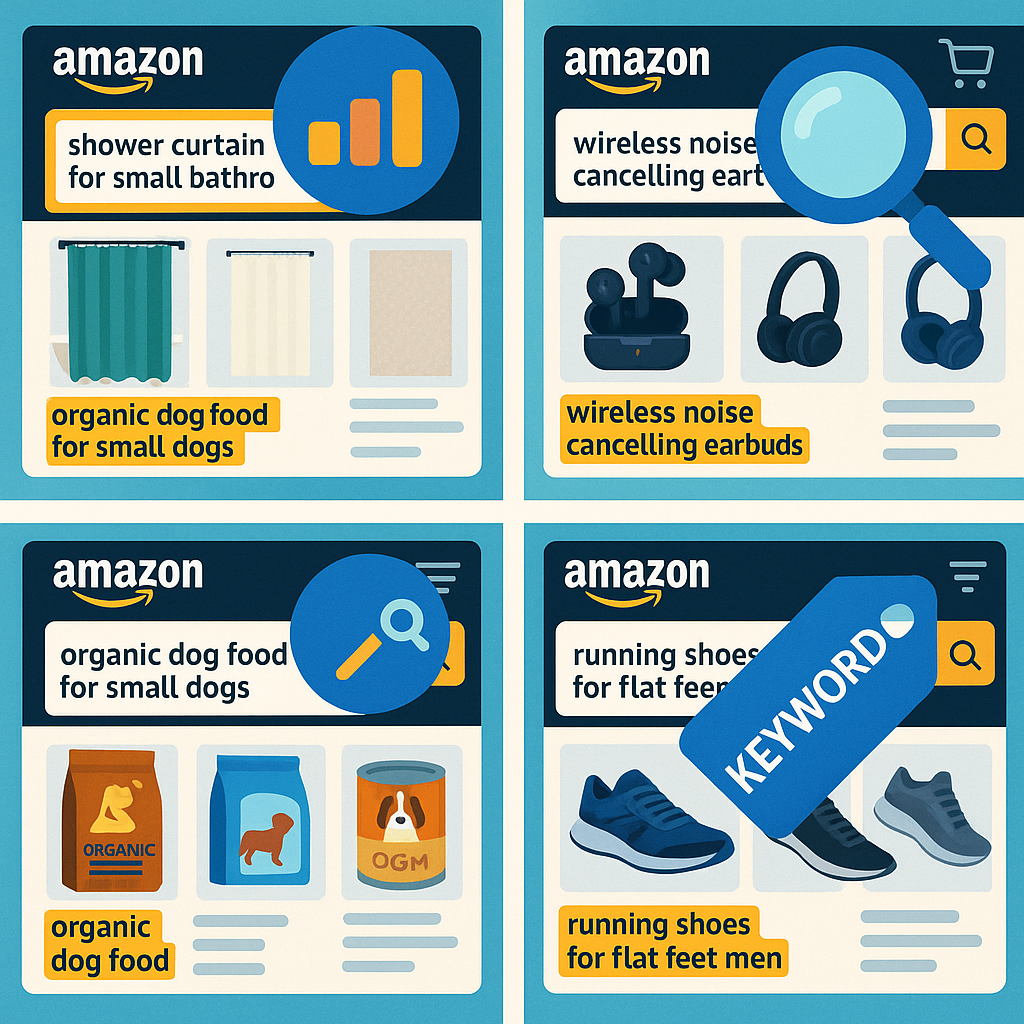
Begin by brainstorming seed keywords that describe your product's core features, benefits, and use cases. Then expand this list using Amazon-specific research tools that provide actual search volume data and competition metrics. Focus on relevancy first—irrelevant keywords might bring traffic but won't convert to sales, potentially harming your listing's performance metrics.
Look beyond obvious primary terms to discover high-value long-tail keywords—specific multi-word phrases with lower competition but strong purchase intent. For instance, rather than just targeting "yoga mat," consider "non-slip yoga mat for hot yoga with alignment lines" which targets a specific customer need.
Using tools and analytics for smarter keyword targeting
Amazon provides sellers with powerful first-party data through Brand Analytics (available to brand-registered sellers). The Search Terms Report reveals actual customer search queries, their search frequency rank, and click-share metrics. This helps identify trending terms and understand which keywords drive actual engagement.
Similarly, Amazon's Product Opportunity Explorer highlights niches with growth potential, competitive intensity, and typical conversion rates. This data can inform not just keyword targeting but overall product development strategy.
For deeper insights, third-party tools like Helium 10, Jungle Scout, and Sellics offer keyword research capabilities specifically designed for Amazon. These tools provide search volume estimates, competitive difficulty scores, and often suggest related keywords you might have missed.
When conducting research, don't overlook your competitors' listings as valuable sources of keyword inspiration. Analyze top-performing products in your category, paying special attention to their titles, bullets, and descriptions to identify potentially valuable terms.
Optimizing product titles and bullet points for CTR and relevance
Your product title is arguably the most critical element of your listing. It needs to be keyword-rich yet readable, containing your most important search terms while clearly communicating what the product is. Amazon recommends different title formulas for different categories, but generally, you'll want to include:
- Brand name
- Product type/line
- Key features (material, color, size, quantity)
- Distinguishing characteristics
For example, a well-optimized title might be: "BrandName Ergonomic Office Chair with Adjustable Lumbar Support, Breathable Mesh, 360° Swivel, Black."
Avoid keyword stuffing, ALL CAPS, promotional phrases ("Best Seller," "Limited Time"), or subjective claims ("Amazing Quality") which violate Amazon's guidelines and can hurt your listing's performance.
Bullet points should highlight your product's top features and benefits, addressing potential questions and concerns upfront. Each bullet should focus on a distinct selling point, beginning with the feature and explaining its benefit. For example: "Adjustable lumbar support contours to your spine, reducing back pain during long work sessions."
Prioritize bullets by importance—many shoppers only read the first two or three. Use all available bullet points (typically five) and aim for 150-200 characters each, incorporating relevant keywords naturally within the context of useful information.
Testing and iterating titles/bullets with Amazon's experiments
Amazon's "Manage Your Experiments" feature allows brand-registered sellers to run A/B tests on titles, main images, and A+ Content. This tool provides direct insights into how changes impact conversion rates over a testing period (typically 4-8 weeks).
When testing titles or bullets, focus on one variable at a time—such as leading with different features or using alternative keyword phrases—to clearly identify what drives improvements. Even small adjustments can yield significant conversion rate increases, particularly for high-traffic listings where minor percentage improvements translate to substantial sales growth.
Writing high-converting product descriptions and leveraging A+ Content
While bullet points highlight key features, the product description allows you to tell a more complete story about your product. This section appears lower on the page but provides space to address additional selling points, usage scenarios, and potential objections.
Structure your description for skimmability using short paragraphs and natural keyword integration. Focus on communicating benefits rather than just features—explain how the product solves problems or improves the customer's life. Include details not covered in the bullets, such as ideal use cases, compatibility information, or care instructions.
A+ Content (formerly Enhanced Brand Content) offers brand-registered sellers a powerful tool to enhance standard product descriptions with rich media and formatted text. This premium content space replaces the traditional product description with visually appealing modules that can include:
- Comparison charts highlighting advantages over competitors
- High-resolution lifestyle imagery showing the product in use
- Brand storytelling elements that build trust and emotional connection
- Technical diagrams explaining product features
- Cross-selling modules featuring related products
According to Amazon, well-executed A+ Content can increase conversion rates by 3-10% on average. When designing A+ Content, maintain visual consistency with your brand, focus on addressing common customer questions, and highlight your unique selling proposition compared to alternatives.
Using high-quality images and alt text to drive trust and sales
Product images directly influence purchasing decisions, with quality visuals building trust and giving shoppers confidence in what they'll receive. Amazon allows up to nine images per listing, and you should utilize this allowance fully with a strategic mix of image types.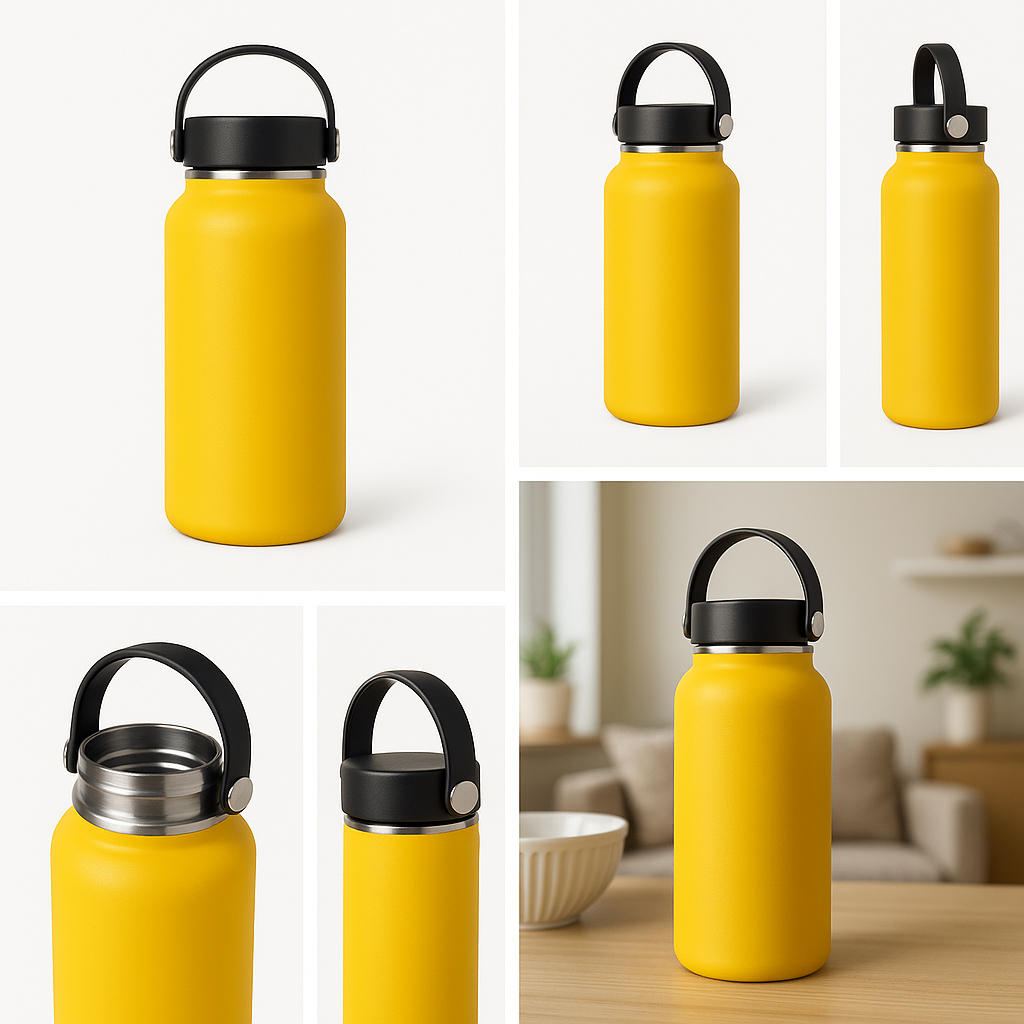
Your main image (the one appearing in search results) must show the product on a pure white background, without props, text overlays, or packaging. It should fill 85% or more of the frame and meet Amazon's technical requirements (1000 pixels on the longest side for zoom functionality).
Secondary images should include:
- Multiple angles showing all sides of the product
- Close-ups highlighting key features or details
- Size/scale reference images showing the product in use
- Lifestyle shots demonstrating the product in its intended environment
- Infographic images explaining features, benefits, or usage
While Amazon's platform doesn't display traditional alt text to customers, the keywords you add to image metadata in Seller Central contribute to search indexing. Each image should have descriptive, keyword-rich alt text that accurately describes what the image shows.
Image quality matters significantly—professional photography consistently outperforms amateur shots in conversion tests. Proper lighting, sharp focus, and high resolution (minimum 1000x1000 pixels, ideally 2000x2000) ensure customers can examine product details through Amazon's zoom feature, reducing uncertainty and return rates.
Pricing tactics and category optimizations for higher sales
Pricing strategy significantly impacts both visibility and conversion rates on Amazon. The platform's algorithm favors competitively priced products, while shoppers often filter by price range or sort search results by price. Your pricing approach should balance profitability with marketplace competitiveness.
Rather than simply matching competitors, analyze your product's unique value proposition. If you offer superior quality or additional features, a slightly higher price point can be justified with proper messaging in your listing content. Conversely, if your product is similar to alternatives, competitive pricing becomes more crucial for conversion.
Proper categorization is equally important for visibility. Amazon's browse tree structure determines which categories your product appears in when customers navigate the site without searching. Selecting the most specific appropriate category improves your chances of appearing in browse results and category-specific best seller rankings.
For products with variations (different sizes, colors, etc.), using parent-child listings consolidates customer reviews and sales history, strengthening overall listing performance. This structure allows shoppers to easily switch between options while maintaining the momentum toward purchase.
Leveraging Amazon's automated pricing tools
Amazon offers automated pricing tools that can adjust your prices dynamically based on rules you establish. The Automate Pricing feature in Seller Central allows you to set pricing rules relative to the Buy Box price, lowest price, or specific competitors.
This automation helps maintain price competitiveness without constant manual adjustments. For example, you might set rules to match the lowest price (within certain parameters) during high-traffic shopping periods, then return to your standard pricing during slower periods to preserve margins.
When using these tools, establish floor prices to prevent unprofitable sales, and monitor performance regularly to ensure your automated rules continue to align with your business objectives as marketplace conditions evolve.
Supercharging sales with reviews, Brand Registry, fulfillment, and advertising
Product reviews function as social proof, significantly influencing purchasing decisions and contributing to ranking performance. While you can't directly solicit positive reviews, Amazon's "Request a Review" button allows you to neutrally ask for feedback 4-30 days after purchase.
The Amazon Vine program provides trusted reviewers with your products in exchange for honest feedback. While participation requires a fee, it offers a legitimate way to jump-start reviews for new listings. Additionally, focusing on product quality and customer service naturally leads to more positive organic reviews.
Enrolling in Amazon Brand Registry provides access to powerful tools including A+ Content, Sponsored Brands advertising, the Brand Analytics dashboard, and enhanced protection against counterfeiters.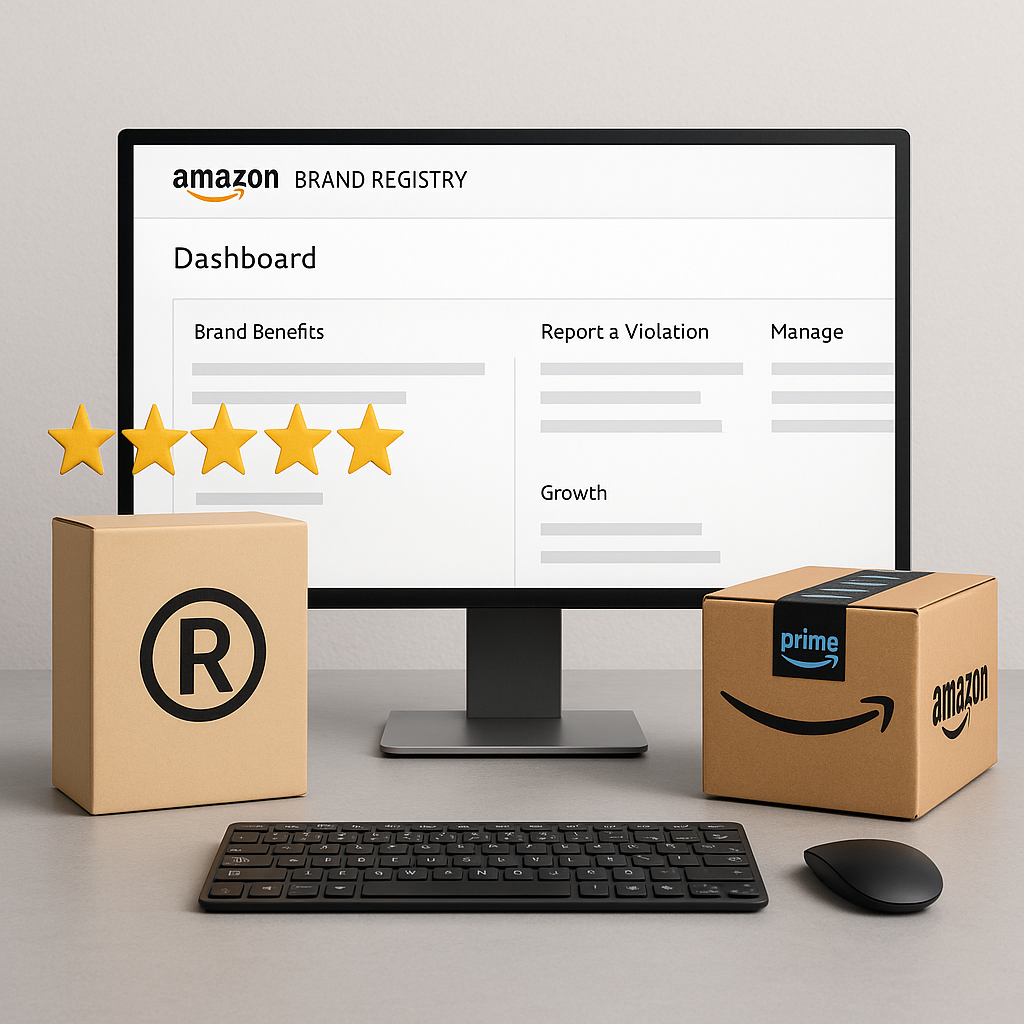
Brand Registry requires a registered trademark but delivers substantial benefits that typically justify the investment.
Fulfillment by Amazon (FBA) can dramatically improve conversion rates by making your products Prime-eligible. Prime members represent Amazon's most active buyers and often filter search results to show only Prime-eligible items. While FBA involves additional fees, the increased visibility and conversion rates frequently offset these costs, particularly for higher-priced items.
Amazon advertising complements organic optimization by providing immediate visibility while you build organic ranking. Sponsored Products campaigns target specific keywords and appear within search results, while Sponsored Brands (available to brand-registered sellers) display your logo and multiple products at the top of search results, enhancing brand awareness.
A strategic advertising approach involves:
- Using automatic campaigns to discover high-converting search terms
- Creating manual campaigns targeting specific keywords with optimized bids
- Developing separate strategies for branded, category, and competitor keywords
- Setting appropriate daily budgets to ensure consistent visibility
- Regularly analyzing performance data to refine targeting and improve ROAS
Conclusion
Amazon product listing optimization is not a one-time effort but an ongoing process requiring regular refinement based on performance data. The most successful sellers adopt a testing mindset, continuously experimenting with improvements to titles, images, bullets, and other listing elements while tracking their impact on search ranking and conversion rates.
Remember that optimization elements work synergistically—keyword-rich content helps customers find your listing, compelling imagery and clear benefit statements drive conversions, and operational excellence (through FBA and customer service) generates positive reviews that further enhance performance.
By implementing these strategies comprehensively and consistently analyzing results, sellers can create a positive feedback loop where improved listing performance leads to higher rankings, increased visibility, and ultimately, sustainable sales growth in Amazon's competitive marketplace.
Frequently Asked Questions
What is Amazon product listing optimization?
Amazon product listing optimization refers to the process of enhancing all elements of your Amazon product detail page—including title, keywords, images, bullet points, descriptions, and backend fields—to improve visibility, rankings, and sales in Amazon search results.
How do backend keywords work on Amazon?
Backend keywords are hidden search terms added in Seller Central. They don't appear on your live product listing but help Amazon match your product to more relevant customer searches, expanding discoverability.
How important are product images for Amazon sales?
Extremely important—high-quality, clear product images following Amazon guidelines significantly increase buyer trust, help drive conversions, and can impact your listing's ranking in search results.
What is A+ Content and how can it help?
A+ Content enables brand-registered sellers to enrich their product pages with images, comparison charts, and enhanced text—proven to boost conversion rates and build brand credibility.
Should I use Amazon PPC to improve my product ranking?
Yes, strategic use of Amazon PPC can dramatically increase your product's visibility, accelerate sales velocity, and help improve your ranking for competitive keywords.
